Pearl of the South Fork
by Audrey E. "Umpy" Osborn, July 2010
The new era of Kia Kima 1948 – 1963: George Milford Billingsley was the first of ten waterfront directors that graced the sandy beach of Kia Kima. An experienced waterfront man from the Camp Currier staff, he was the director from 1948 through 1951. From his top bunk on the inside wall of the “Rats Nest”, he kept a watchful eye over the waterfront when he was off duty. He was quick to correct and expected the best from his staff; his booming voice thru the waterfront megaphone was legend. His legacy was a long line of highly trained waterfront directors starting with: Lou Pritchett ‘52–‘53, Steve Young ‘54, Mike Moyers ‘55, Buddy Keltner ‘56, David Fleming ‘57-‘58, Bobby “B” Brown ‘59–‘60, Dick Drake ‘61, Jim Moore ‘62, and Bill Harrison ‘63. The directors and their staffs ruled the sandy beach at Kia Kima on the beautiful South Fork River with a strong demanding voice and a firm hand.
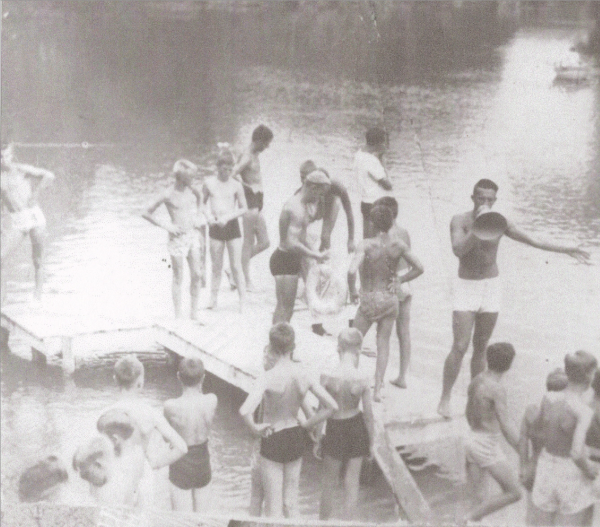
Pearl of the South Fork
For many years, entry to Kamp Kia Kima was via row boat from the meadow across the South Fork River to the sandy beach of the waterfront or to an adjacent dock. This was the appropriate entry point for it was the “heart beat” of Kia Kima”. Every camper would deal with and come to love the many and varied facets of the waterfront.
The sandy beach and its tanned muscular staff were the envy of scouts entering camp. If Kia Kima was the “Nest of Eagles”, the waterfront was the “Lair of “Poseidon”. His thunderous voice through the waterfront megaphone was frequently heard from Simonton’s mess hall to Miramichee. We were fearful to be the brunt of George Billingsley’s booming voice and one did his best to do everything according to the rules of the waterfront: keep that elbow straight; feather that blade; where’s your buddy tag? We feared his booming voice; Wow, I hope it’s not for me!!! “Uncle Dudley’s” waterfront staff ruled the only Sand Beach on the South Fork from a tower and a whistle on a lanyard around their necks.
If Hong Kong is the Pearl of the Pacific then the Kia Kima waterfront was the undeniable “Pearl of the South Fork”, set below a limestone bastion at the very foot of a small mountain called White Horse. Whereupon sits our dear old camp nestled against the sky, the “Nest of “Eagles”, Kamp Kia Kima.
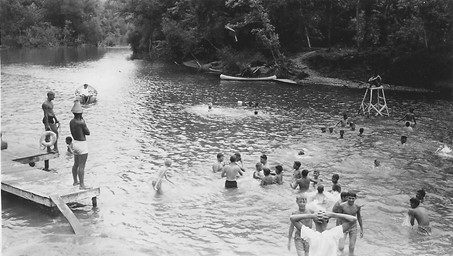
Adjoining the beach was what we called the island with tall hardwoods and one large tall black willow. A big rope was tied to a large limb approximately 20 feet up, that the waterfront and other staff “Titans” would climb. It stood as a sentinel for the beach and the islands large rich deposit of native sand. Little did I know that in 1953 I would be a freshman staffer and for one day be a mining engineer for the excavation for a large quantity of this magnificent silica.
It was an honor to be a Kia Kima staffer that summer and most special was to share cabin number two with my cousin, Kenneth Ray “Ken” Osborn, my good friend, Eddie Freiberg and Ole 97 brother, Louis, “Lou Pie” Pritchett. It was a hoot, the six weeks or so, with Lou who served as waterfront director for two summers, six years total on the Kia Kima staff. He was also one of Kia Kima’s original Indian Dancers. His last summer camp was 1953 before joining Procter & Gamble as a soap salesman.
Anyway, my biggest event was being selected the OA taskmaster for three OA ordeal candidates. It had been only one year since I had taken my ordeal. I was 15 years old. I would conduct all alone the “task” for a Scoutmaster, a large man at least 40 years old; Billy Stewart, future Kia Kima program director in 1958; and the famous “Gate Mouth”, Perry Gaither. He was a freshman staffer like me and one of “Lou Pie’s” most faithful. Gaither talked constantly and modeled after Lou as an Indian dancer. Perry, like Lou, became a waterfront icon and was a favorite of the campers. Like his predecessors, his roaring voice was a fixture on our sandy beach and revered by many.
That Saturday morning started early with our simple tools: one wheelbarrow, two shovels, and two rakes. The day was sunny and hot and stayed that way until the sun slowly dipped toward White Horse Mountain. First we removed a layer of clay sediment above the sand deposit. The three candidates would load the wheelbarrow, push it 50 or so yards to the beach, load, after load, after load; then spread the sand with rakes over the entire waterfront. Soon the swift current of the cool South Fork was calling out to them but they could not respond. The candidates were not even allowed to put their feet in the river. I knew they would gladly drink their fill if only they could. I kept a watchful eye on their every move and kept them moving except for measured brief shady water breaks spaced throughout the long hot day. I sat in the cool shade where I could observe both operations, during their constant silence and drank lots of water. After this all day ordeal, I understood why our beach was sandy and I had a deeper respect for the one and only sand beach on the river, the beautiful “Pearl of the South Fork”.

At our 1998 OKKPA reunion I overheard Perry Gaither telling an old Kia Kima buddy about his Order of the Arrow ordeal. He talked about the relentless Ozark sun, his intense thirst, faltering fatigue and how he longed to dive into the cold, swift current of the river. “Gate Mouth” said it was his hardest day ever at Kia Kima. So demanding was the ordeal that he had no recollection of who the relentless taskmaster for the trio could have been.
There was nothing better than after a long, hot, humid day in camp, in the evening shade to jump into the refreshing South Fork waters and enjoy its mystic powers with your buddy. Wouldn’t it be great to do it just one more time!!!
Here’s to the: “Pearl of the South Fork”.
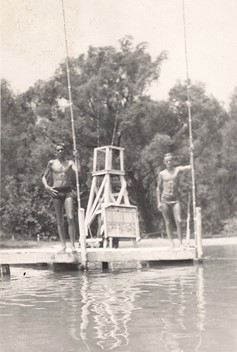
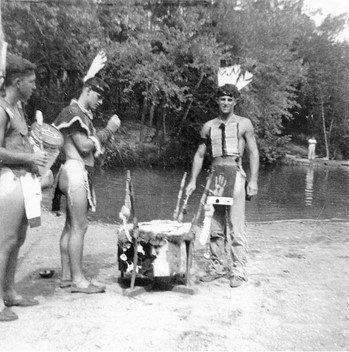
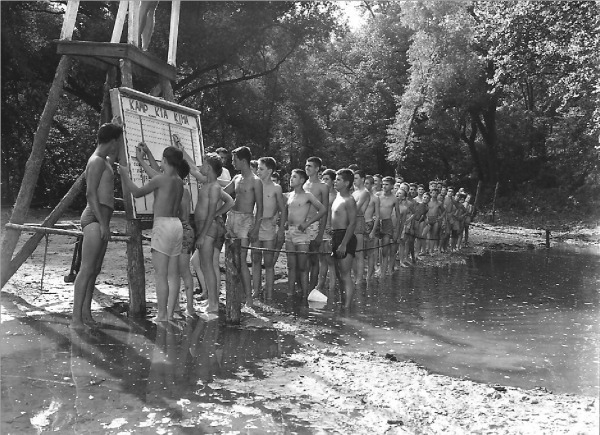
1949 KIA KIMA Waterfront
“Campers” lined up for swimming and advanced aquatic instruction. That took place around 9:00 a.m. First, everyone must have a “buddy tag” indicating his waterfront classification.
Countless numbers of scouts moved from non swimmer to beginner and on to swimmer while at Kia Kima. A swimmer classification entitled the scout to work on his Eagle required “swimming and life saving” merit badges. That was a big step.